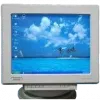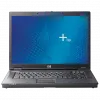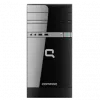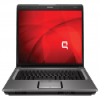
Compaq Computer Corporation was a company founded in 1982, that developed, sold and supported computers and related products and services. Compaq produced some of the first IBM PC compatible computers, being the first company to legally reverse-engineer IBM Personal Computer. It rose to become the largest supplier of PC systems during the 1990s before being overtaken by Dell in 2001. Compaq was acquired for US$25 billion by HP in 2002.
The company was formed by Rod Canion, Jim Harris and Bill Murto — former Texas Instruments senior managers. Murto departed in 1987, while Canion (President and CEO) and Harris (SVP of Engineering) left under a shakeup in 1991 that saw Eckhard Pfeiffer appointed CEO. Ben Rosen provided the venture capital financing for the fledging company and served as chairman of the board for 18 years from 1983 until September 28, 2000, when he retired and was succeeded by Michael Capellas.
Prior to its takeover the company was headquartered in a facility in Northwest unincorporated Harris County, Texas, United States that now serves as HP's United States headquarters.
Headquarters
Compaq's (now HP United States') headquarter campus consisted of 80 acres (320,000 m2) of land which contained 15 office buildings, 7 manufacturing buildings, a product conference center, an employee cafeteria, mechanical laboratories, warehouses, and chemical handling facilities.
History
Compaq was founded in February 1982 by Rod Canion, Jim Harris and Bill Murto, three senior managers from semiconductor manufacturer Texas Instruments. Each invested $1,000 to form the company. Their first venture capital came from Benjamin M. Rosen and Sevin Rosen Funds. The first Compaq PC was sketched out on a table napkin by Ted Papajohn while dining with the founders in a Houston restaurant. The company was founded with the temporary name Gateway Technology. The name "COMPAQ" was said to be derived from "Compatibility and Quality" but this explanation was an afterthought. The name was chosen from many suggested by Ogilvy and Mather; it being the name least rejected.
Two key marketing executives in Compaq's early years, Jim D'Arezzo and Sparky Sparks, had come from IBM's PC Group. Other key executives responsible for the company's meteoric growth in the late 80s and early 90s were Ross A. Cooley, another former IBM associate, who served for many years as SVP of GM North America; Michael Swavely, who was the company's chief marketing officer in the early years, and eventually ran the North America organization, later passing along that responsibility to Mr. Cooley, when Swavely retired. In the United States, Brendan A. "Mac" McLoughlin (another long time IBM executive) led the company's field sales organization after starting up the Western U.S. Area of Operations. These gifted executives, along with other key contributors, including Kevin Ellington, Douglas Johns, Steven Flannigan, and Gary Stimac, helped the company with the IBM Corporation in all personal computer sales categories, after many predicted that none could compete with the behemoth.
Introduction of Compaq Portable
In November 1982 Compaq announced their first product, the Compaq Portable, a portable IBM PC compatible personal computer. It was released in March 1983 at $2995, considerably more affordable than the Canadian Hyperion. The Compaq Portable was one of the progenitors of today's laptop; some called it a "suitcase computer" for its size and the look of its case. It was the second IBM PC compatible, being capable of running all software that would run on an IBM PC. It was a commercial success, selling 53,000 units in its first year and generating $111 million in sales revenue. The Compaq Portable was the first in the range of the Compaq Portable series. Compaq was able to market a legal IBM clone because IBM mostly used "off the shelf" parts for their PC. Furthermore, Microsoft had kept the right to license the operating system to other computer manufacturers. The only part which had to be duplicated was the BIOS, which Compaq did legally by using clean room reverse engineering at a cost of $1 million. Phoenix Technologies would shortly follow their lead, but soon "clone BIOSes" were available from many other companies who reverse engineered IBM's design, then sold their version to the PC clone manufacturers.
Compaq DeskPro
On June 28, 1984 Compaq released the Compaq Deskpro, a 16-bit desktop computer using an Intel 8086 microprocessor running at 7.14 MHz. It was considerably faster than an IBM PC and was, like the Compaq Portable, also capable of running IBM software. It was Compaq's first non-portable computer and began the Compaq Deskpro line of computers.
Compaq DeskPro 386
When Compaq introduced the first PC based on Intel's new 80386 microprocessor, the Compaq Deskpro 386, in 1986, it marked the first CPU change to the PC platform that was not initiated by IBM. An IBM-made 386 machine eventually reached the market seven months later, but by that time Compaq was the 386 supplier of choice and IBM had lost its image of technical leadership.
For the first three months after announcement the Deskpro 386 shipped with Windows/386. This was a version of Windows 2.1 adapted for the 80386 processor. Support for the virtual 8086 mode was added by Compaq engineers.
Compaq SystemPro
This technical leadership and the rivalry with IBM was emphasized when the Systempro server was launched in late 1989 - this was a true server product with standard support for a second CPU and RAID, but also the first product to feature the EISA bus, designed in reaction to IBM's MCA (MicroChannel Architecture). Prior to developing EISA, Compaq invested significant resources into reverse engineering MCA. Compaq shelved the idea of cloning MCA and formed an alliance with HP and seven others to develop EISA.
The 1990s
Ouster of co-founder Canion
When Michael S. Swavely retired as president of Compaq's North American division on July 12, 1991, Eckhard Pfeiffer was named to succeed him. Pfeiffer also received the title of Chief Operating Officer. He joined Compaq from Texas Instruments, and established operations from scratch in both Europe and Asia. Pfeiffer was given $20,000 USD to start up Compaq Europe. He started up Compaq's first overseas office in Munich in 1984. By 1990, Compaq Europe was a $2 billion business, and foreign sales contributed 54 percent of Compaq's revenues.
Pfeiffer became President and CEO of Compaq in 1991, as a result of a boardroom coup led by board chairman Ben Rosen that forced co-founder Rod Canion to resign as President and CEO. Canion had allowed competitors such as Dell Computer, AST Research, and Gateway 2000 to undercut Compaq with cheaper offerings, that led to a $71 million loss for that quarter, Compaq's first loss as a company. An analyst stated that "Compaq has made a lot of tactical errors in the last year and a half. They were trend-setters; now they are lagging".
Rosen and Canion had disagreed about how to counter the cheaper Asian PC imports, as Canion wanted Compaq to build lower cost PCs in-house, while Rosen believed that Compaq needed to buy standard components from suppliers and reach the market faster. While Canion developed an 18-month plan to create a line of low-priced computers, Rosen sent his own Compaq engineering team to Comdex without Canion's knowledge and discovered that a low-priced PC could be made in half the time and at lower cost than Canion's initiative. In addition, it was believed that Canion's consensus-style management slowed the company's ability to react in the market, whereas Pfeiffer's autocratic style would be suited to price and product competition. Rosen initiated a 14 hour board meeting, and the directors also interviewed Pfeiffer for several hours without Canion's knowledge. At the conclusion, the board was unanimous in picking Pfeiffer over Canion.
Canion declined an offer to remain on Compaq's board and was bitter about his ouster as he didn't speak to Rosen for years, although their relationship became cordial again. In 1999, Canion admitted that his ouster was justified, saying "I was burned out. I needed to leave. He [Rosen] felt I didn't have a strong sense of urgency". Two weeks after Canion's ouster, five other senior executives resigned, including remaining company founder James C. Harris as SVP of Engineering. These departures were motivated by an enhanced severance or early retirement, as well as an imminent demotion as their functions were to be shifted to vice presidents.
Market ascension
Under Pfeiffer's tenure as chief executive, Compaq entered the retail computer market with the Presario which one of the first manufacturers in the mid-1990s to market a sub-$1000 PC. In order to maintain the prices it wanted, Compaq became the first first-tier computer manufacturer to utilize CPUs from AMD and Cyrix. The two price wars resulting from Compaq's actions ultimately drove numerous competitors from the market, such as Packard Bell, and by 1994 Compaq had overtaken Apple Computer and even surpassed I.B.M. as the top PC manufacturer. Compaq's inventory and gross margins were better than that of its rivals which enabled it wage the price wars.
Management shuffle
In 1996, despite record sales and profits at Compaq, Pfeiffer initiated a major management shakeup in the senior ranks. Pfeiffer's vision was to move Compaq beyond its main business of manufacturing retail PCs and into the more lucrative business services and solutions that IBM did well at. Earl Mason, hired from Inland Steel effective on May 1996, immediately made an impact as the new CFO. Under Mason's guidance, Compaq utilized its assets more efficiently instead of focusing just on income and profits, which increased Compaq's cash from $700 million to nearly $5 billion in one year. Also Compaq's return on invested capital (after-tax operating profit divided by operating assets) has doubled to 50 percent from 25 percent in that period.
In January 1998, Compaq was at its height. CEO Pfeiffer boldly predicted that the Microsoft-Intel "Wintel" duopoly would be replaced by "Wintelpaq".
Acquisitions
Pfeiffer also made several major acquisitions. In 1997, Compaq bought Tandem Computers, known for their NonStop server line. This acquisition instantly gave Compaq a presence in the higher end business computing market.
In 1998, Compaq acquired Digital Equipment Corporation for a then-industry record of $9 billion USD. Digital Equipment, which had twice as many employees as Compaq, has been a leading company in the previous generation of computing during the 1970s and early 1980s but it had struggled since then. This acquisition made Compaq, at the time, the world's second largest computer maker in the world in terms of revenue behind I.B.M.
However, Pfeiffer had little vision for what the combined companies should do, or indeed how the three dramatically different cultures could work as a single entity, and Compaq struggled as a result of a strategy that had the company caught in between the low end and high end. Mark Anderson, president of Strategic News Service, a research firm based in Friday Harbor, Wash. was quoted as saying The kind of goals he had sounded good to shareholders -- like being a $50 billion company by the year 2000, or to beat I.B.M. -- but they didn't have anything to do with customers. The new C.E.O. should look at everything Eckhard acquired and ask: did the customer benefit from that. If the answer isn't yes, they should get rid of it. On one hand, Compaq struggled to compete in the PC market with the Dell Computer Corporation, which sold directly to buyers, avoiding the dealer channel and its markup, and built each machine to order to keep inventories and costs at a minimum. At the same time, Compaq, though its acquisitions of the Digital Equipment Corporation last year and Tandem Computer in 1997, has tried to become a major systems company, like I.B.M. and Hewlett-Packard.
Ouster of Pfeiffer
By summer 1998, Compaq was suffering from product-quality problems. Pfeiffer also refused to develop a potential successor, rebuffing Rosen's suggestion to recruit a few executives to create the position of Compaq president. The board complained that Pfeiffer was too removed from management and the troops, as he surrounded himself with a "clique" of Chief Financial Officer Earl Mason, Senior Vice-President John Rose, and Human Resources Chief Hans Gutsch.
Compaq was hit with two class-action lawsuits, as a result of several executives selling $50 million USD of stock before a conference call with analysts, where they noted that demand for PCs was slowing down.
On April 17, 1999, just nine days after Compaq reported first-quarter profit being at half of what analysts had expected, the latest in a string of earnings disappointments, Pfeiffer was forced to resign as CEO in a coup led by board chairman Ben Rosen. Reportedly, at the special board meeting held on April 15, the directors were unanimous in dismissing Pfeiffer. During three out of the last six quarters of Pfeiffer's tenure, the company's revenues or earnings had missed expectations. While rival Dell Computer had 55% growth in U.S. PC sales in the first quarter of 1999, Compaq could only manage 10%. Rosen suggested that the accelerating change brought about by the Internet had overtaken Compaq's management team, saying "As a company engaged in transforming its industry for the Internet era, we must have the organizational flexibility necessary to move at Internet speed." In a statement, Pfieffer said "Compaq has come a long way since I joined the company in 1983" and "under Ben's guidance, I know this company will realize its potential." Rosen's priority was to have Compaq catchup as an E-commerce competitor, and he also moved to streamline oeprations and reduce the indecision that plagued the company.
Rosen assumed the capacity of interim CEO and began "cleaning house", as shortly afterward many of Pfeiffer's top executives resigned or were pushed out, including John Rando, Earl Mason, and John Rose. Rando, senior vice president and general manager of Compaq Services, who had been said to be the heir-apparent to Pfieffer; his division had performed strongly as it had sales of $1.6 billion for the first quarter compared to $113 million in 1998, which met expectations and was anticipated to post accelerated and profitable growth going forward. CFO Mason, who had previously been offered the job of chief executive of a company outside the personal computer industry, informed Compaq's board that he accepted the offer. Rose, head of Compaq's Enterprise Computing group, was reportedly upset that he was not considered for the CEO vacancy; his division reportedly accounted for one third of Compaq's revenues and likely the largest part of its profits.
Pfieffer's permanent replacement was Michael Capellas, who had been serving as Compaq's CIO. Immediately after Pfieffer's ouster, Capellas was elevated to interim chief operating officer by Rosen, and after several months Capellas was made President and CEO, also assuming the title of Chairman on September 28, 2000 when Rosen retired from the board of directors.
Late 1990s-2000s
Struggles
Capellas was able to restore some of the luster lost in the latter part of the Pfeiffer era and he repaired the relationship with Microsoft which had deteriorated under his predecessor's tenure, but the company still struggled against lower-cost competitors such as Dell who took over the top spot of PC manufacturer from Compaq in 2001.
During November 1999, Compaq began to work with Microsoft to create the first in a line of small-scale, web-based computer systems called MSN Companions.
In 1998, Compaq also signed new sales and equipment alliance with NaviSite. Under the pact, Compaq agreed to promote and sell NaviSite Web hosting services. In return, NaviSite took Compaq as a preferred provider for its storage and Intel-based servers.
Compaq struggled as a result of the collapse of the Dot-com bubble bust, which hurt sales of their high-end systems in 2001 and 2002, and they managed only a small profit in a few quarters during these years. They also accumulated $1.7 billion in short-term debt around this time. The stock price of Compaq, which was around $25 when Capellas became CEO, was trading at half that by 2002.
Acqusition by HP
An HP Compaq computer and an HP Deskjet 5740 printer owned by the Houston Independent School District
In 2002, Compaq signed a merger agreement with Hewlett-Packard for $24.2 billion, including $14.45 billion for goodwill, where each Compaq share would be exchanged for 0.6325 of a Hewlett-Packard share. HP's offer was said by some to be overvaluing Compaq, due to its shaky financial performance in the past recent years (there were rumors that it could run out of money in 12 months and be forced to cease business operations had it stayed independent), as well as Compaq's own more conservative valuation of its assets.
Hewlett-Packard had reported yearly revenues of $47 billion, while Compaq's was $40 billion, and the combined company would have been close to IBM's $90 billion revenues. It was projected to have $2.5 billion in annual cost savings by mid-2004. The expected layoffs at Compaq and HP, 8500 and 9000 jobs, respectively, would leave the combined company with a workforce of 145,000.
Both companies had to seek approval from their shareholders through separate special meetings. While Compaq shareholders unanimously approved the deal, there was a public proxy battle within HP as the deal was strongly opposed by numerous large HP shareholders, including the sons of the company founders, Walter Hewlett and David W. Packard, as well as the California Public Employees’ Retirement System (Calpers) and the Ontario Teachers Pension Plan.
Detractors of the deal noted that buying Compaq was a "distraction" that would not directly help HP take on IBM's breadth or Dell Computer's direct sales model, plus there were significant cultural differences between HP and Compaq. While supporters of the merger argued that there would be economies of scale and that the sales of PCs would drive sales of printers and cameras, Walter Hewlett was convinced that PCs were a low-margin but risky business that would not contribute and would likely dilute the old HP's traditionally profitable Imaging and Printing division. One of Compaq's few bright spots was its services business, which was outperforming HP's own services sector.
The merger was approved by HP shareholders only after the narrowest of margins, and allegations of vote buying (primarily involving an alleged last-second back-room deal with Deutsche Bank) haunted the new company. It was subsequently disclosed that HP had retained Deutsche Bank's investment banking division in January 2002 to assist in the merger. HP had agreed to pay Deutsche Bank $1 million guaranteed, and another $1 million contingent upon approval of the merger. On August 19, 2003, the U.S. SEC charged Deutsche Bank with failing to disclose a material conflict of interest in its voting of client proxies for the merger and imposed a civil penalty of $750,000. Deutsche Bank consented without admitting or denying the findings.
Compaq's pre-merger ticker symbol was CPQ. This was combined with Hewlett-Packard's ticker symbol (HWP) to create the current ticker symbol (HPQ).
Post-Merger Compaq
Capellas, Compaq's last Chairman and CEO, became president of the post-merger Hewlett-Packard, under Chairman and CEO Carly Fiorina, to ease the integration of the two companies. However, Capellas was reported not to be happy with his role, being said not to be utilized and being unlikely to become CEO as the board supported Fiorina. Capellas stepped down on November 12, 2002, just six months on the job, to become CEO of MCI Worldcom where he would lead its acquisition by Verizon. Capella's former role of president was not filled as the executives who reported to him then reported directly to the CEO.
Fiorina helmed HP for nearly three years after Capellas left. HP laid off thousands of former Compaq, DEC, HP, and Tandem employees, its stock price generally declined and profits did not perk up. Several senior executives from the Compaq side including Jeff Clarke and Peter Blackmore would resign or be ousted from the post-merger HP. Though the combination of both companies' PC manufacturing initially made it the number one, it soon lost the lead and further market share to Dell which squeezed HP on low end PCs. HP was also unable to compete effectively with IBM in the high-end server market. In addition, the merging of the stagnant Compaq computer assembly business with HP's lucrative printing and imaging division was criticized for obstructive the profitability of the printing/imaging segment. Overall, it has been suggested that the purchase of Compaq was not a good move for HP, due to the narrow profit margins in the commoditized PC business, especially in light of IBM's 2005 announcement to sell its PC division to Lenovo. The Inquirer noted that the continued low return on investment and small margins of HP's personal computer manufacturing business, now named the Personal Systems Group, "continues to be what it was in the individual companies, not much more than a job creation scheme for its employees".
In February 2005, the Board of Directors ousted Fiorina. Former Compaq CEO Capellas was mentioned by some as a potential successor, but several months afterwards, Mark Hurd was hired as President and CEO of HP. Hurd separated the PC division from the imaging and printing division and renamed it the Personal Systems Group, placing it under the leadership of EVP Todd R. Bradley. The combined Compaq-HP PC manufacturing division has since been reinvigorated by Hurd's restructuring and now generates more revenue than the traditionally more profitable printers. By late 2006, HP had retook the #1 sales position of PCs from Dell, which struggled with missed estimates and poor quality, and has held that rank ever since.
Most Compaq products have been re-branded with the HP nameplate, such as the company's market leading ProLiant server line, while the Compaq brand remains on only some consumer-oriented and budget products, notably Compaq Presario PCs. HP's business computers line was discontinued in favour of the Compaq Evo line, which was rebranded HP Compaq. HP's Jornada PDAs were replaced by Compaq iPAQ PDAs, which were renamed HP iPAQ. All Compaq computers now ship with HP software.
In May 2007, HP announced in a press release a new logo for their Compaq Division to be placed on the new model Compaq Presarios.
In 2008, HP reshuffled its business line notebooks. The "Compaq" name from its "HP Compaq" series was originally used for all of HP's business and budget notebooks. However, the HP EliteBook line became the top of the business notebook lineup while the HP Compaq B series became its middle business line. As of early 2009, the "HP ProBook" filled out HP's low end business lineup.
In 2009, HP sold part of Compaq's former headquarters to the Lone Star College System.
In 2010, the last Compaq Presario branded laptop was produced at an HP computer assembly facility in China. Since then, the Presario was rebranded under HP's laptop computer line as the HP 2000 series.
On August 18, 2011, then-CEO of HP Leo Apotheker announced plans for a partial or full spinoff of the Personal Systems Group. The PC unit had the lowest profit margin although it accounted for nearly a third of HP’s overall revenues in 2010. HP was still selling more PCs than any other vendor, shipping 14.9 million PCs in the second quarter of 2011 (17.5% of the market according to Gartner), while Dell and Lenovo were tied for second place, each with more than a 12% share of the market and shipments of over 10 million units.









